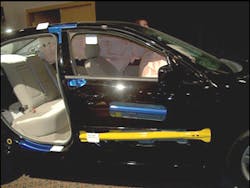'Crash Course' Quick Drill Series - Part XII
Ford reworked the original Fusion with major design and engineering improvements.
Topic: 2007 Ford Focus Automobile
In 1998. the Ford Motor company introduced the Ford Fusion at the Geneva Switzerland Motor Show. In 1999, it was released for sale in North America. In 2005, Ford reworked the original Fusion with major design and engineering improvements.
For this Crash Course drill, we will review the Ford Fusion vehicle and its' safety systems as they influence EMS and rescue/extrication work at crash scenes. Have your crew visit a new car dealership to view this vehicle and become familiar with its' design features and safety equipment.
The occupant-sensing technology for a passenger in the front seat of the Fusion will turn the front-passenger seat air bag on or off depending on the size of the seat occupant. It is possible that a crash could activate the sensors and not deploy this frontal airbag. If a rescuer climbed onto this seat to access a driver patient their weight could cause the passenger frontal airbag to deploy if the electrical system had not been shut down.
Ford continues to recommend that children under 12 ride in the back seat secured by a safety belt or in a child safety seat. Seat-mounted, side-impact air bags are optional on all series.
The seat-mounted side impact airbags use stored gas inflator modules to deploy the airbag. The roof-mounted airbags are also the stored gas inflator type. The Fusion's roof airbag inflator module is mounted at what has become the most common location; along the inside of the rear C-pillar.
Rescuers must review their protocols for cutting any roof structure at a crash scene. The Fusion roof-mounted airbags are a prime example of how automakers are placing the stored gas inflators exactly in our 'cut zone'.
Responders must be trained to strip the trim prior to cutting any roof pillar or roof rail structure. We must avoid cutting into a pressurized stored gas inflator. If you find a stored gas inflator on one side of the vehicle, there will be a mate to it in exactly the same location on the other side of the vehicle. If you do not find any airbags on one side of the roof, there won't be any on the other side either.
The cut-away display of the body structure of the Ford Fusion sedan shows the inner portions of the B-pillar. The label on this display states "B-pillar uses multiple layers of steel for greater strength above the window line". That means that the manufacturer has placed more layers of specially formulated high-strength steel along the portion of the B-pillar that runs from the window line to the roof rail. Once again, this is exactly our 'cut zone'.
If hydraulic power cutters bog down when working to cut through this B-pillar, it is because the multiple layers have been squeezed together and are resisting the cutting power of the tool. In this case, continue to work the tool at different angles of attack. Also, consider having a reciprocating saw ready to go. The reciprocating saw with a good demolition-quality rescue blade will be able to cut this pillar if your power hydraulics can't.
Crash Course Teaching Point:
- Strip the trim before cutting any roof pillar or roof rail.
- Stay off the front passenger's seat if that airbag has not deployed in a head-on collision; it's a SMART seat.
- If your power cutters have trouble cutting through B-pillars on 2007 model year vehicles, it's because of the addition of multiple layers of high-strength steel. Get a recip saw ready to back you up.
Be Informed...Be Ready...Beware!
